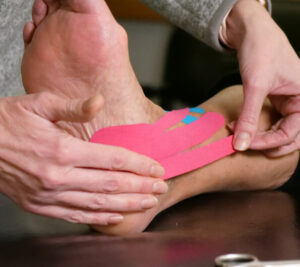Therapeutic Taping
Therapeutic Taping is often used as part of a treatment plan in Physical Therapy. There are many different types of tape that can be used for a variety of different reasons. Overall, the techniques implemented by a Physical Therapist are used to promote healing of tissue that has previously been injured.
The purpose of the tape can fall into one of two categories:
-
-
The first being physiological, which can influence change with pain perception, swelling control or simply giving the patient cueing to self correct a body position.
-
The other is mechanical, meaning the tape is applied to provide modification to faulty movement patterns. These improper movement patterns could have caused the injury or do not allow the injured tissue to heal properly
-

Types Of Therapeutic Taping:
-
Kinesiology Tape: Kinesiology Tape is an elastic tape that provides sensory input to an area but still allows for full range of motion. Kinesiology Tape helps by lifting the skin from the tissues below it (fascia, muscles, connective tissue and nerve receptors). When the tape is applied it causes compression or decompression of these areas allowing it to alter pain signals to the brain. Kinesiology Tape includes Rock Tape, Spider Tape or KT Tape. Some common diagnoses/conditions Kinesiology Tape is used for include shin splints, knee pain, plantar fasciitis, Achilles tendon pain, general muscle pain and swelling.
-
Leukotape: Leukotape is a more rigid tape used for pain reduction and re aligning structures to address faulty joint movement. The taping method is a 2 step process, beginning with a soft protective tape applied to the skin. A more rigid tape is then applied on top of the soft tape to influence how the structure will move. Leukotape includes the Mcconnel taping techniques to address knee alignment and Low Dye Tape techniques for foot and ankle alignment. Some common diagnoses low dye tape helps is patellofemoral pain, ITB friction syndrome, chondromalacia, Plantar fasciitis and shoulder impingement.
-
What is the difference between the 2 taping techniques?
Leukotape is used to create support around a joint whereas Kinesiology tape, such as KT tape and Rock tape, retains its elasticity to allow support without hindering joint movement.
-
Is Therapeutic Taping right for you?
Not all patients require the use of therapeutic tape, and your Physical Therapist can determine if it is appropriate for you.
Therapeutic tape is used to aid with the healing process, not as a cure for any condition. It should be combined with other interventions of care to see optimal results and should eventually be weaned once realistic goals are obtained. Most therapeutic tape is latex free; however, some are not, and this should be taken into consideration prior to its use.
Before you use taping techniques on yourself, you should always be evaluated by a physical therapist. You don’t want to be exciting a muscle that’s already overactive, turning off a muscle that’s already under-active or stabilizing a joint that is hypomobile.
The Physical Therapists at Dedham Health Physical Therapy are trained in several taping techniques. Based on your present condition, your therapist can perform taping to assist with the following:-
-
Mechanical Corrections
-
Inhibition of Muscle Spasms
-
Reductions in Swelling
-
Postural Corrections
-
Facilitation of Inactive Muscles
-
-

